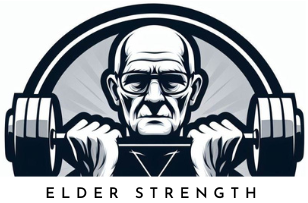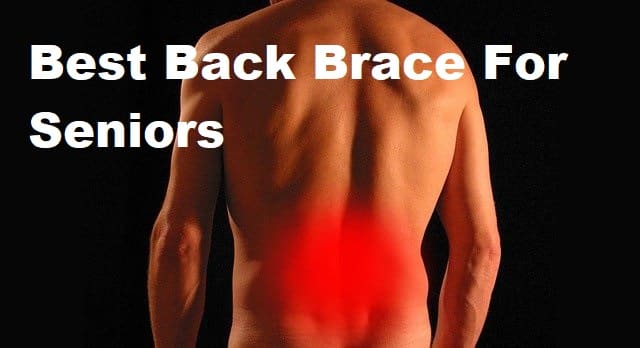If you are looking for the best back brace for seniors, you’ve come to the right place! In this short guide, you will learn what to look for in a back brace and how to choose the right one.
Lower back pain is one of the most common health problems with seniors. It can range from annoying to debilitating but the good news is that it’s often not life-threatening in any way.
But I’m sure you know how negatively lower back pain can affect your life since you are reading this. It’s always there in the background, making every move more difficult.
Lower back pain can severely limit your mobility since the natural reaction is to start avoiding the pain. The bad news is that this usually makes the pain worse and more chronic.
Reduced activity and exercise are likely to only exacerbate the pain in the long run. I’ll talk more about that in a minute.
Many people who suffer from lower back pain find comfort in back braces. A device that helps to support the lower back, reducing the pressure on the spine and back musculature.
But there are some considerations you need to take when choosing one. The most important one being, if you really need one.
What Is A Back Brace?
A back brace is a device that helps you keep your trunk upright by supporting your back. There are several different kinds of back braces but the typical one for lower back pain is the belt or corset type.
Upper back braces are also often called posture correctors and you can find more information about them in my article: Best posture corrector for seniors.
There are also full back braces that support the entire back with a harness design. In my opinion, this kind of device should only be used in the guidance of medical professionals, because they change the mechanisms of the trunk musculature so significantly.
So the most common type back brace is the corset that goes around your waist and lower back. Its idea is to support the abdominal muscles and the lower back musculature, taking some pressure off the spine and the inflamed muscles around it.
A good back brace can significantly reduce the pain in your back and help you keep moving and active. This way a back brace can help you start your rehabilitation.
You can’t improve circulation and strengthen the core muscles if you are bedridden after all.
Do You Really Need One?
Now here’s the important part. Back braces are exactly that, braces. They often don’t do anything to fix the real issue that is causing the back pain. It often helps to fix the symptom but not the cause.
There are several possible reasons for back pain and only a medical professional can diagnose the cause for you.
But keep in mind that often lower back pain is caused, or at least exacerbated by weak core musculature. Meaning the muscles around your abdomen and lower back.
Wearing a back brace works because it gives additional support to these muscles and the spine. But the problem is that weak muscles that are partly causing the problem will become even weaker when the brace reduces their workload.
Once again, this is not always the case, but it’s a serious consideration. That’s why I recommend that you consult a medical professional that can help you diagnose the cause and design an effective rehabilitation plan.
A back brace can be great for alleviating acute pain and to help you keep active if the main is otherwise debilitating. But in the long run, it runs the risk of becoming a crutch. You become dependent on it.
That’s why it’s always wise to create a plan that aims to fix the problem. If you have serious spinal problems like scoliosis and herniations, this might not always be completely possible.
But physiotherapy and improving strength in the core muscle can alleviate the back pain significantly in many cases. So only use a brace if you absolutely have to and even then it should only be used as a tool to help you alleviate the pain in the long run.
What Are Back Braces Good For Then?
A back brace is great for protecting the back if you have to do a lot of manual work that involves lifting and awkward positions.
These are often the situation where people pull their back or herniate the disc. Things like moving furniture, doing construction or car maintenance, yard work, etc. can
Even in these situations, it’s wise to assess if you really need to use the brace. If you are doing construction work for six hours, for example, you could do a few hours without the brace and then wear it for the reminder.
The danger to the back lies in losing control when fatigue sets in. But if you wear a brace constantly, you will soon need it all the time. So it’s about finding the right balance.
The brace will help you keep your back aligned and in good positions and offer additional support when lifting heavy items like furniture. On occasions like this, it’s good to put the brace on beforehand if you are not confident of your strength.
Considerations For A Back Brace
If you do decide to get a back brace on your own, there are a couple of things you should consider.
First of all the brace needs to be adjustable and sturdy enough. Many cheap neoprene and velcro based supports might work for a week or two, but the neoprene will stretch and the velcro will lose its ability to keep the brace tight.
That’s why I recommend you invest in one that’s made out of tough fabric like Nylon and has a secure closing mechanism. A pulley system can help you put the brace on more securely, especially if you have mobility issues in your shoulders.
One key thing is also that the brace needs to be machine washable. Wearing the brace for several hours daily will cause sweat to build up under it so it needs to be washed at least weekly. You should always wear a t-shirt underneath for this reason.
Some braces offer a pocket or a pouch to place heat or cold packs. This can be a very useful feature as heat especially often helps to relieve tension and reduce the pain in the back.
The Best Back Brace
In case you want to try a back brace on your own, my recommendation is the Flex Guard Support Lower Back Brace (That’s an affiliate link, I earn a small commission if you buy through it. It costs you no extra and it’s how I keep this site running.)
This brace has an ingenious compression system that offers superior support to the lower back. It’s built from tough padded nylon fabric and the compression system has additional nylon belts in a pulley system. This creates a sturdy and durable construction.
The brace includes a pocket for adding heat or cold backs and it comes in two different adjustable sizes that should cover almost everyone’s needs.
Most importantly the Flex Guar back brace has been used successfully by thousands of people. Just Amazon alone has over 2000 user testimonials with an average rating of 4.5 out of 5, meaning that thousands of people have found the product effective and durable.
Conclusion
I hope you found this short guide useful and it helped you find the best back support for yourself. If you have any questions, you can contact me through the comments section below.
Back brace can be a great tool for alleviating back pain but it should never be your first or only line of defense. That’s why I always recommend that you get a proper diagnosis and plan your rehabilitation with a medical professional.
Not doing so can cause further harm and prolong back pain. That said, in many mild cases a back brace can help you maintain an active lifestyle and help strengthen the muscles around your back and abdominals.
This can help you alleviate the pain permanently as your back receives more support from the surrounding tissues. Just make sure that you use the back brace for the short term and only if you have to. Otherwise, you run the risk of becoming dependent on it.
If you want ideas on how to start strengthening your body, check out my free strength training routine for seniors for some ideas!
Thanks for reading and if you found the post useful, consider sharing it on social media to support my work!
See you next time.


My husband suffers from lower back pain, but he has never tried a back brace. Even if it doesn’t fix the problem completely, he can at least get an ease from the pain. Sometimes, it is so bad, he can hardly move. Going to the chiropractor can be costly, so the back bace will definitely come in handy. Thanks for sharing such helpful info. We’ll certainly get one.
Sorry to hear about your husband’s back pain Carol. Chiropractors can often alleviate the pain if there is an acute misalignment that caused it but with chronic backpain it usually takes physiotherapy and strengthening the muscles of the core to alleviate some of the pain. Unfortunately some people never get their back pain fully resolved. Good luck to your husband and never give up looking for a solution!
i have scoliosis. osteopetrosis, titanium disc in both 5 & 6,with titanium discs. also titanium in my neck and jaw.right nowni am suffering with severe pain from a scatic nerve it only gets worse even with streathesn.. whew what a mouthful.,i hsve seen ads with braces that claim to help the scatis as well as scolious, is this true? not sure which vest is right for me thank you, jeannie
Hi Jeanie. First of all, sorry to hear about your health issues. You have quite a lot going on so I would urge you to seek medical advice (which this is not) instead of trying to treat your symptoms on your own. The general back braces I refer to in this article are only good for temporary situations like a pulled back muscle and it’s highly unlikely they would help with severe pain. They might even make your condition worse. So definitely see a doctor to plan treatment options. Good luck and all the best!